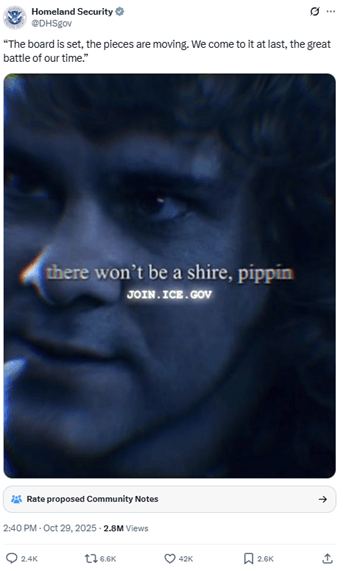
Three.
There are only three ways to explain why DHS might think that the story of the Lord of the Rings represents a favorable analogy for its present goals, or that the War of the Ring is in any way analogous to policies meant to reduce the stock and flow of illegal migrants to the United States. Either they don’t understand what they’re saying (ignorance), they know exactly what they’re saying (malice), or they don’t care what they’re saying (cynicism).
The first explanation is ignorance. It begins from the idea – first proposed by Elon Musk earlier this week - that The Shire is a model of traditional England, only kept in its pristine state for the gentle hobbits by the labors of hard men. There’s a little truth in that – but only a little. Tolkien makes clear in his letters (178, 181 and 190) that the Shire is neither England per se, nor England as it ought to be, but rather a small corner of England as he remembers it simply from his Victorian-era youth. And mostly topologically speaking, since his main annoyance with a Dutch translator was that replacing English place names in The Shire with Dutch ones would conjure images of Holland’s flat and flooded lands, which were all wrong for it. Likewise, it is true that Aragorn – as Strider – impresses on the young hobbits that their land is only kept peaceful because of the efforts of the Dúnedain in fencing evil from their borders.
Yet for all Tolkien’s disdain for allegory, the story of the Lord of the Rings cannot help but to be the story of a man who came home from the First World War only to realize that war can never be wholly left behind on the battlefields. It always comes home.
That’s because the world doesn’t care about a proper plot arc. When Versailles ended the war, it was the resolution to the climax of that chapter of the story of our world. But England does not sail to its resolution like some formulaic novel. It struggles for decades against the wholesale loss of a generation of men, the ruin of centuries-old families. It fights against a change in its values and principles in response to the war, a sentiment the professor would echo later in the waning years of the Second World War in an outburst against power abused in the name of country and race.
…our converse turned on the difficulties of discovering what common factors if any existed in the notions associated with freedom, as used at present. I don't believe there are any, for the word has been so abused by propaganda that it has ceased to have any value for reason and become a mere emotional dose for generating heat. At most, it would seem to imply that those who domineer over you should speak (natively) the same language – which in the last resort is all that the confused ideas of race or nation boil down to; or class, for that matter, in England.
J.R.R. Tolkien, in a September 1944 letter to his son Christopher Tolkien, who was stationed in South Africa training to be an RAF pilot
The narrative arc of the Lord of the Rings mirrors this murky resolution. After the final victory over Sauron – which is ultimately a victory not won by arms but by the rejection of the use of an evil power that would be temporarily useful to set things right – the hobbits want to go home. Alas, war has gotten there first. Only it isn’t the war or peril that Aragorn warned him about, of orcs and trolls and the descent of gruesome terrors from the Misty Mountains and the ancient ruins of Angmar into The Shire.
The Scouring of the Shire, like the true story of England after the Great War, exposes the protagonists to a new conflict after the main resolution of the story has already taken place. The peril that comes to The Shire takes place when an old, wealthy, and powerful political outsider takes advantage of the environment of fear to set himself up as an authoritarian ruler. He enlists the support of local law enforcement to institute new rules by fiat, to surround himself with loyalists, to hoard scarce luxuries for his own use, to tightly control the trade of goods, and to sow distrust among the people. Lord almighty, there’s even a bit where the petty king rips up the gardens around the grand home he makes his seat of government. And did I mention that the ruler, before he came to power, had spent an entire life and career making fun of the uselessness of the people of The Shire? Or that all of this ends when four young hobbits who remember what matters in The Shire rouse the people to resist the shirriffs and send the old, wealthy, and powerful politician on his way?
I, um, do not think protecting The Shire is the analogy that ICE wants to conjure in support of its present ambitions. If this was the case, it was an argument from ignorance.
The second possible explanation is that DHS thinks there is something in the context of the specific scene captured for the meme that relates to aggressive and, at times, clearly unconstitutional detention and deportation actions.
Now, the scene in question was manufactured for the films, but since that’s what they used, let’s explore just a bit further. Thirty seconds before Merry delivers this line to Pippin – “there won’t be a shire, Pippin!” – he has literally finished telling the leader of the ents, another race of beings, that they must unite with the other free peoples against evil because they are “part of this world.” The film version of Treebeard only relents when he sees the scars of industry and environmental destruction wrought by Saruman from his fortress at Isengard. The hobbits’ fear, too, is not of racial mixing or replacement but of the loss of forests and a pristine environment. It is a globalist appeal to a creature that is literally a tree from a place of shared values about conserving the natural environment.
But the quotation in the tweet also references a later speech by Gandalf upon his arrival with Pippin in Minas Tirith. “The Great Battle of our Time” is an addition to the film’s script to add dramatic effect. What is that battle? Ah, well that would be the battle of men against an army of orcs, trolls, wraiths, monstrous fellbeasts, and yes, other evil men. Or perhaps, more broadly, against Sauron, the fallen angel ruling over those creatures from his tower beyond the plains of Gorgoroth.
I can’t tell you this is not the analogy they had in mind for the targets of ICE activities, just that I hope it isn’t. The only explanation it offers is pure malice.
The third explanation is simpler and the one I think most likely: that it’s a badass speech about fighting some thing, a cool image, and a reference that everybody knows.
I know this kind of thing may seem harmless. Sometimes it is. At the same time, we are observing in real-time how social networks convey the power to rouse entire blocs of citizens with exactly these kinds of powerful symbols and language, and that institutions, companies, influencers, politicians, and governments are rapidly discovering that they don’t need analogies or arguments that work.
They simply need symbols that resonate inside the minds of those who hear them. And for the first time in history, they can deliver such symbols unceasingly and at scale.
Within each of our minds, we are not just roused; we are affected by the underlying system of meanings connecting these symbols to others. We cannot help maintaining the connections of an analogy to the destruction of orcs, to the characterization of our opponent as a force of malevolence and evil worthy of utter ruin. The socially networked age is an age of political rhetoric as pure pathos, an age in which all of our symbols will be used this way – seemingly casually and with plausible deniability – to conjure consent for ideas and policies we would never support if they were presented to us as dry argumentation or through manipulation or lies.
As always, clear eyes and full hearts. Clear eyes to know that our lot is to be saturated by such cynical use of symbols for the remainder of our lives. Full hearts to stake claims on and defend the symbols that are part of our oldest stories - and to resist the cynical use of them precisely as we would a ring of power.




.png&w=3840&q=100)
